I had occasion on a recent trip to place myself into history. In San Diego, California, the USS Midway, an American aircraft carrier is docked as a permanent museum and provides a wonderful window into the forward most arm of America’s military capacity in this dangerous world in which we live. Aircraft carriers in World War II became the means of projecting power across the globe, proven first by Japan in her spectacular raid on Pearl Harbor, and magnified by the catastrophic vulnerability of the traditional king of the seas, the battleship, with the Japanese airborne destruction of the HMS Prince of Wales and HMS Repulse off Singapore all in December, 1941. By the end of the war, the United States had over 50 aircraft carriers roaming the seas and dominated all the sea lanes in a fashion not seen since the height of the British Imperial Navy of Lord Nelson’s time.
The USS Midway, commissioned at the end of the war, was the supreme example of the art of carrier building in her time. 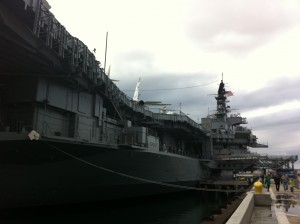 She was larger, more maneuverable ship than her Essex style counterparts of the era, and with her like designed compatriots, the USS Franklin D Roosevelt and the USS Coral Sea, were the last craft designed for propeller craft take off and landing. She was nearly 1000 feet long, capable of launching over 100 aircraft, sailing at 33 knots, and home to over 4000 sailors – a true floating city of power. The Midway ended up serving for the next 40 years through both the Vietnam conflict and Desert Storm before being decommissioned in 1992. Though the United States eventually went to a nuclear class carrier design even larger than the Midway, the ship proved versatile enough to head a carrier group in the Persian Gulf during Desert Storm launching hundreds of F-18 sorties over Kuwait and Iraq that contributed to the overwhelming victory.
She was larger, more maneuverable ship than her Essex style counterparts of the era, and with her like designed compatriots, the USS Franklin D Roosevelt and the USS Coral Sea, were the last craft designed for propeller craft take off and landing. She was nearly 1000 feet long, capable of launching over 100 aircraft, sailing at 33 knots, and home to over 4000 sailors – a true floating city of power. The Midway ended up serving for the next 40 years through both the Vietnam conflict and Desert Storm before being decommissioned in 1992. Though the United States eventually went to a nuclear class carrier design even larger than the Midway, the ship proved versatile enough to head a carrier group in the Persian Gulf during Desert Storm launching hundreds of F-18 sorties over Kuwait and Iraq that contributed to the overwhelming victory.
The museun allows a very intimate look at almost all aspects of the ship. Despite the enormous size of the ship, the multiple bulkheads and millions of yards of exposed wires and cable give the vistor a claustrophobic sense when traversing the inner decks. This feeling is immediately relieved by entering the enormous hanger deck where the aircraft are stored and serviced. 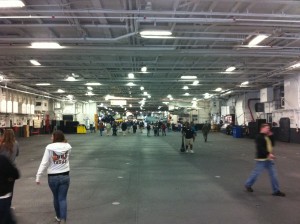
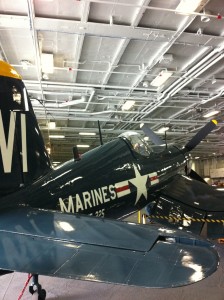 The planes are transitioned by elevator to the even more spacious flight deck, where the dangerous ballet of launching craft was practiced by thousands of highly trained flight teams over the years. The reality of taking a craft from 0 to 200 miles an hour over several hundred feet to launch and the converse, from 200 miles an hour to a standing stop over the same distance with scores of fully armed fully fueled planes and scores of scurrying flight personnel is a awe inspiring and palpably dangerous concept.
The planes are transitioned by elevator to the even more spacious flight deck, where the dangerous ballet of launching craft was practiced by thousands of highly trained flight teams over the years. The reality of taking a craft from 0 to 200 miles an hour over several hundred feet to launch and the converse, from 200 miles an hour to a standing stop over the same distance with scores of fully armed fully fueled planes and scores of scurrying flight personnel is a awe inspiring and palpably dangerous concept.
From the aircraft decks one travels to the intellectual center of the plane, the so called “Island”, where the communications, mission planning, deck activity coordination, and the captain’s bridge inhabit. The space is particularly confined to make room for the critical space of the flight deck activities, and is rested to the side of the carrier. 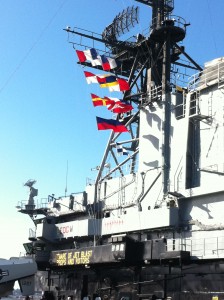
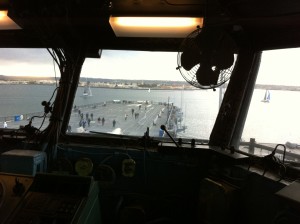 The Air Boss on the Midway was flight deck level, always a squadron leader who understood all the capacities and limitations of the flight team, and had full control of the launch process.
The Air Boss on the Midway was flight deck level, always a squadron leader who understood all the capacities and limitations of the flight team, and had full control of the launch process. 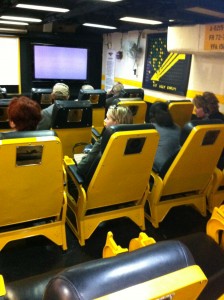 The ship’s navigation, steering, and direction emanate from the bridge which stands several stories over the deck with full view of the deck and the sea beyond. Just beyond the bridge is the communications and mission projection rooms, where, coordination of the complicated actions of this massive sea enterprise is coordinated with the multiple naval craft in the group through radar and radio communication, and nowadays, computer and GPS.
The ship’s navigation, steering, and direction emanate from the bridge which stands several stories over the deck with full view of the deck and the sea beyond. Just beyond the bridge is the communications and mission projection rooms, where, coordination of the complicated actions of this massive sea enterprise is coordinated with the multiple naval craft in the group through radar and radio communication, and nowadays, computer and GPS.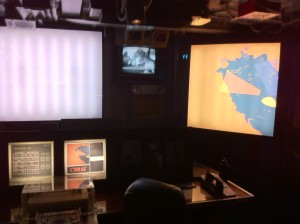
The final image and all encompassing sense of the enormous sea power projected by a ship like this comes down to standing on the deck with the planes that are the multiple arrows of the carrier quiver. What does it take in the process to steel one’s nerves to land a plane on a pitching deck at night in high seas is not for me comprehensible, but somehow this nation continues to find such people who time and time again volunteer and perform beyond all expectation this difficult task. The practice and precision required is the highest expression of military training and the United States with eleven super-carrier groups manning all shipborne seas is the master performer of this art.
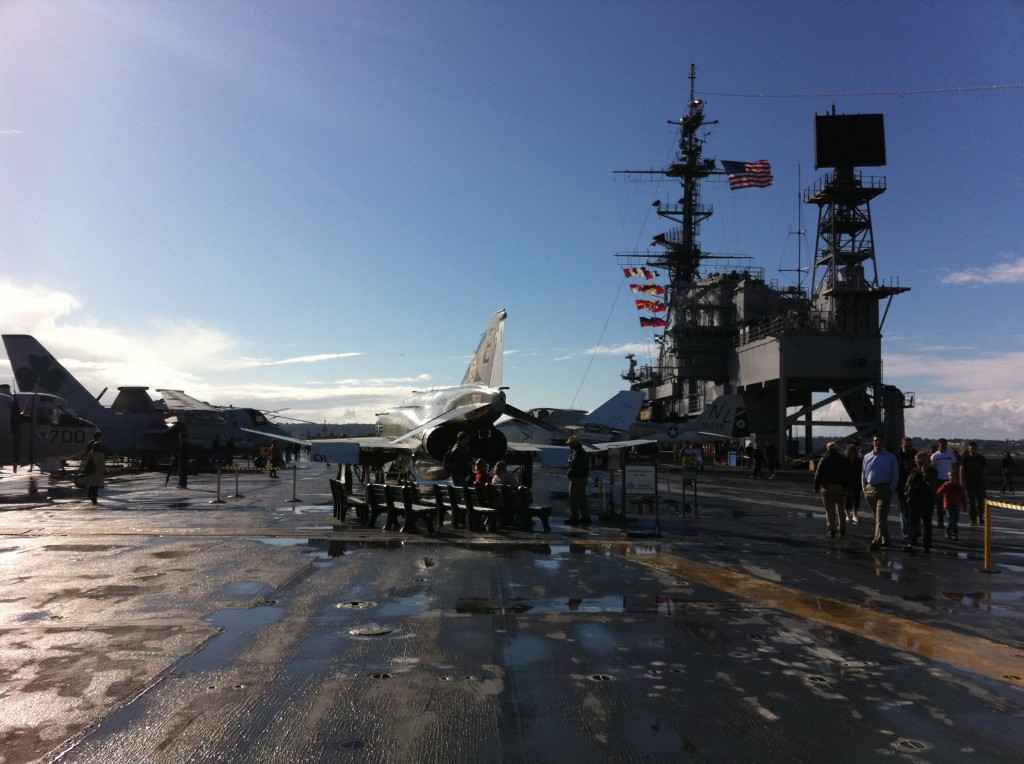
We can argue amongst ourselves always as to whether the investment and sacrifice necessary to create this magnificent floating warrior ship is ultimately worth it, but if you get the chance to see it in person, I think you will realize that if it is to be done, this nation has achieved the ultimate in this particular expression of modern power.
Loved it. Make have to take a trip and take a tour. Thanks
Served on her during operation Frequent Wind evacuation of south Vietnam